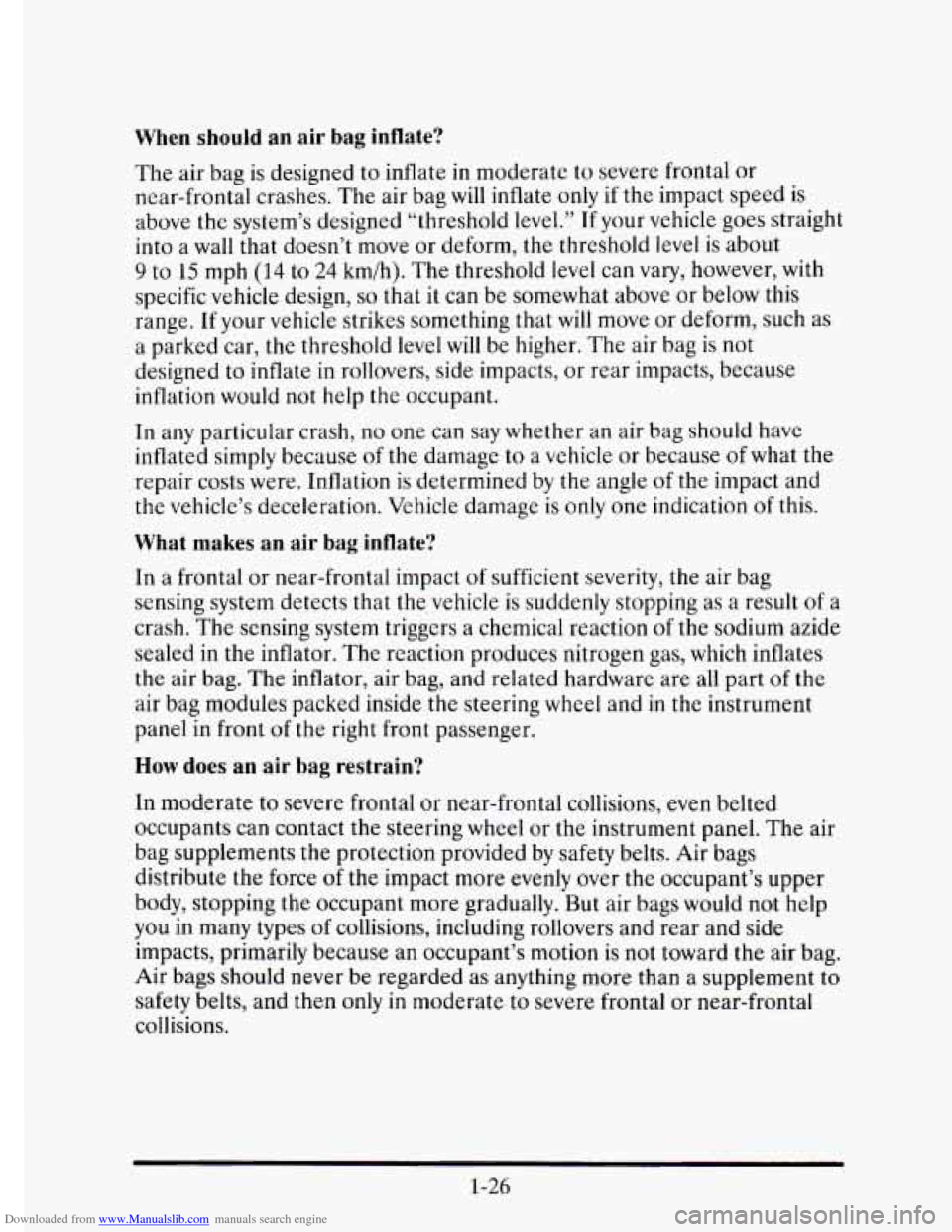Page 34 of 395
Downloaded from www.Manualslib.com manuals search engine The lap part of the belt should be worn low and snug on the hips, just
touching the thighs.
In a crash, this applies force to the strong pelvic
bones. And you’d be less likely to slide under the lap belt.
If you slid
under it, the belt would apply force at your abdomen. This could cause
serious or
even fatal injuries. The shoulder belt should go over the
shoulder and across the chest. These parts
of the body are best able to
take belt restraining forces.
The safety belt locks
if there’s a sudden stop or crash.
1-15
Page 35 of 395
Downloaded from www.Manualslib.com manuals search engine Shoulder Belt Tightness Adjustment
Your car has a shoulder belt tightness adjustment feature. If the shoulder
belt seems too tight, adjust it before
you begin to drive.
1. Sit well back in the seat.
2. Start pulling the shoulder belt out.
3. Just before it reaches the end, give it a quick pull.
1-16
Page 36 of 395
Downloaded from www.Manualslib.com manuals search engine 4. Let the belt go back all the way. You should hear a slight clicking
sound.
If you don't, the adjustment feature won't set, and you'll have
to start again.
5. Now you can add a small amount of slack. Lean forward slightly, then
sit back.
If you've added more than 1 inch (25 mm) of slack, pull the
shoulder belt out as you did before and start again.
If you move around in the vehicle enough, pull out the shoulder belt,
or
open your door, the belt will become tight again. If this happens, you can
reset it.
1-17
Page 37 of 395
Downloaded from www.Manualslib.com manuals search engine Q: What’s wrong with this?
k The shoulder belt is too loose. It won’t give nearly as much
protection this way.
1-18
Page 38 of 395
Downloaded from www.Manualslib.com manuals search engine n
Q: What’s wrong with this?
I
__
A: The belt is buckled in the wrong place.
1-19
Page 39 of 395
Downloaded from www.Manualslib.com manuals search engine Q: What’s wrong with this?
A: The shoulder belt is worn under the arm. It should be worn over the
shoulder
at all times.
1-20
P
Page 41 of 395
Downloaded from www.Manualslib.com manuals search engine To unlatch the belt, just push the button on the buckle. The belt should go
back out of the way.
Before you close the door, be sure the belt
is out of the way. If you slam
the
door on it, you can damage both the belt and your vehicle.
SUPPLEMENTA INFLATABLE
RESTMNT SYSTEM (SIR)
This part explains the Supplemental Inflatable Restraint (SIR), or air bag,
system.
Your Cadillac has two air bags -- one air bag for the driver and another air
bag for the right front passenger.
Here are the most important things
to know about the air bag system:
1-22
Page 45 of 395

Downloaded from www.Manualslib.com manuals search engine When should an air bag inflate?
The air bag is designed to inflate in moderate to severe frontal or
near-frontal crashes. The air bag
will inflate only if the impact speed is
above the system’s designed “threshold level.” If your vehicle goes straight
into a wall that doesn’t move or deform, the threshold level is about
9 to 15 mph (14 to 24 km/h). The threshold level can vary, however, with
specific vehicle design,
so that it can be somewhat above or below this
range. If your vehicle strikes something that
will move or deform, such as
a parked car, the threshold level
will be higher. The air bag is not
designed to inflate
in rollovers, side impacts, or rear impacts, because
inflation would not help thc occupant.
In any particular crash,
no one can say whether an air bag should have
inflated simply because
of the damage to a vehicle or because of what the
repair costs were. Inflation is determined by the angle of the impact and
the vehicle’s deceleration. Vehicle damage
is only one indication of this.
What makes an air bag inflate?
In a frontal or near-frontal impact of sufficient severity, the air bag
sensing system detects that the vehicle
is suddenly stopping as a result of a
crash. The sensing system triggers a chemical reaction of the sodium azide
sealed in the inflator. The reaction produces nitrogen gas, which inflates
the air bag. The inflator, air bag, and related hardware are all part
of the
air bag modules packed inside the steering wheel and in the instrument
panel in front of the right front passenger.
How does an air bag restrain?
In moderate to severe frontal or near-frontal collisions, even belted
occupants can contact the steering wheel or the instrument panel. The air
bag supplements the protection provided by safety belts. Air bags
distribute the force
of the impact more evenly over the occupant’s upper
body, stopping the occupant more gradually. But air bags would not help
you in many types of collisions, including rollovers and rear and side
impacts, primarily because an occupant’s motion
is not toward the air bag.
Air bags should never be regarded as anything more than a supplement to
safety belts, and then only in moderate to severe frontal or near-frontal
collisions.